
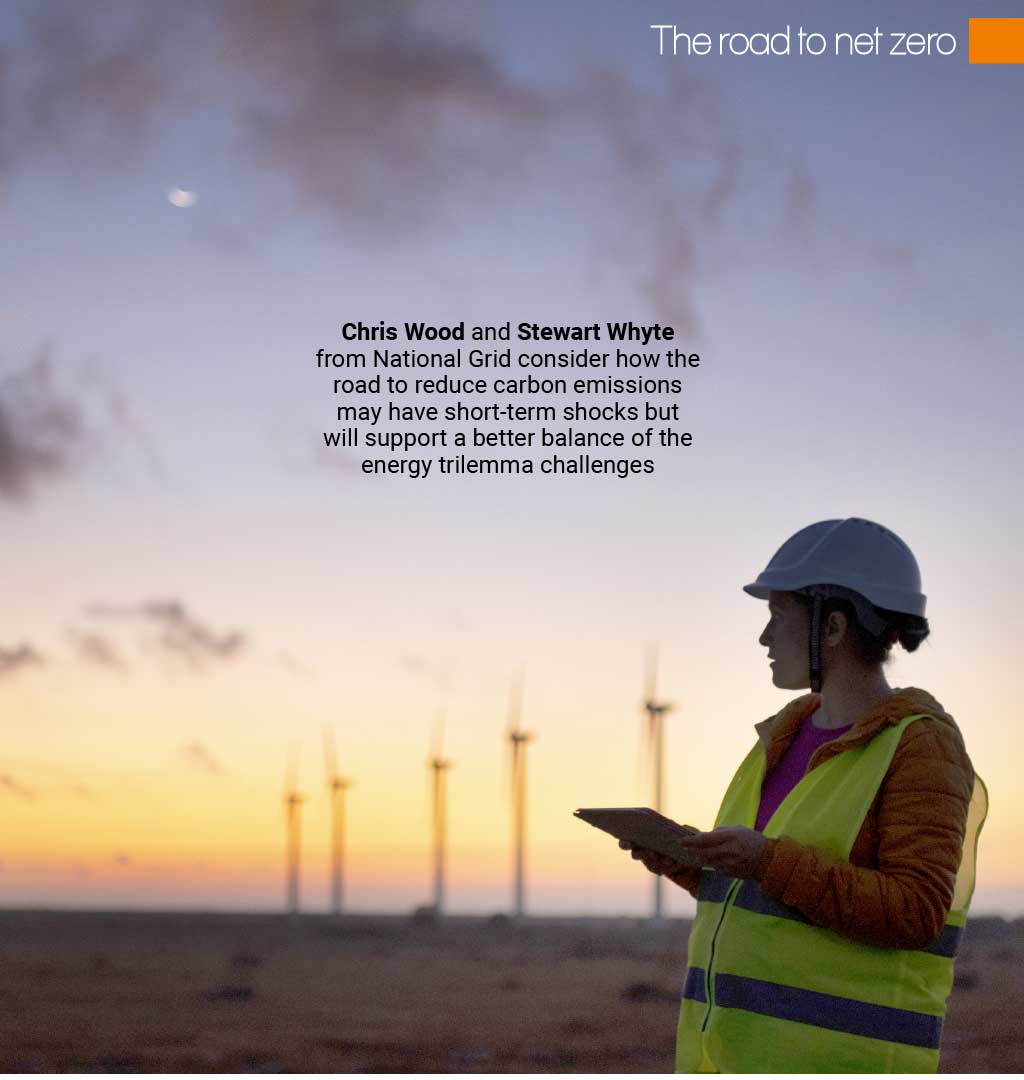
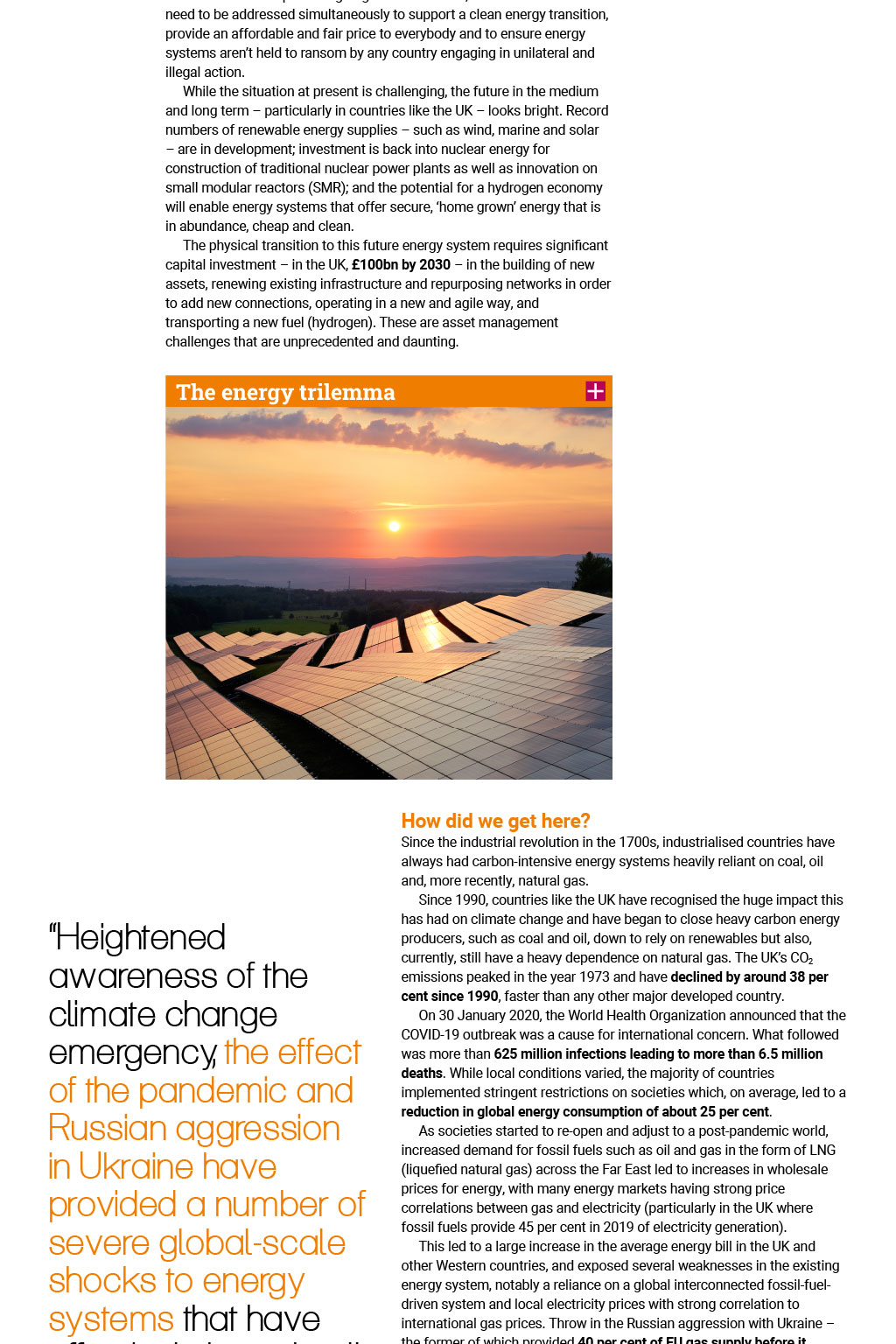
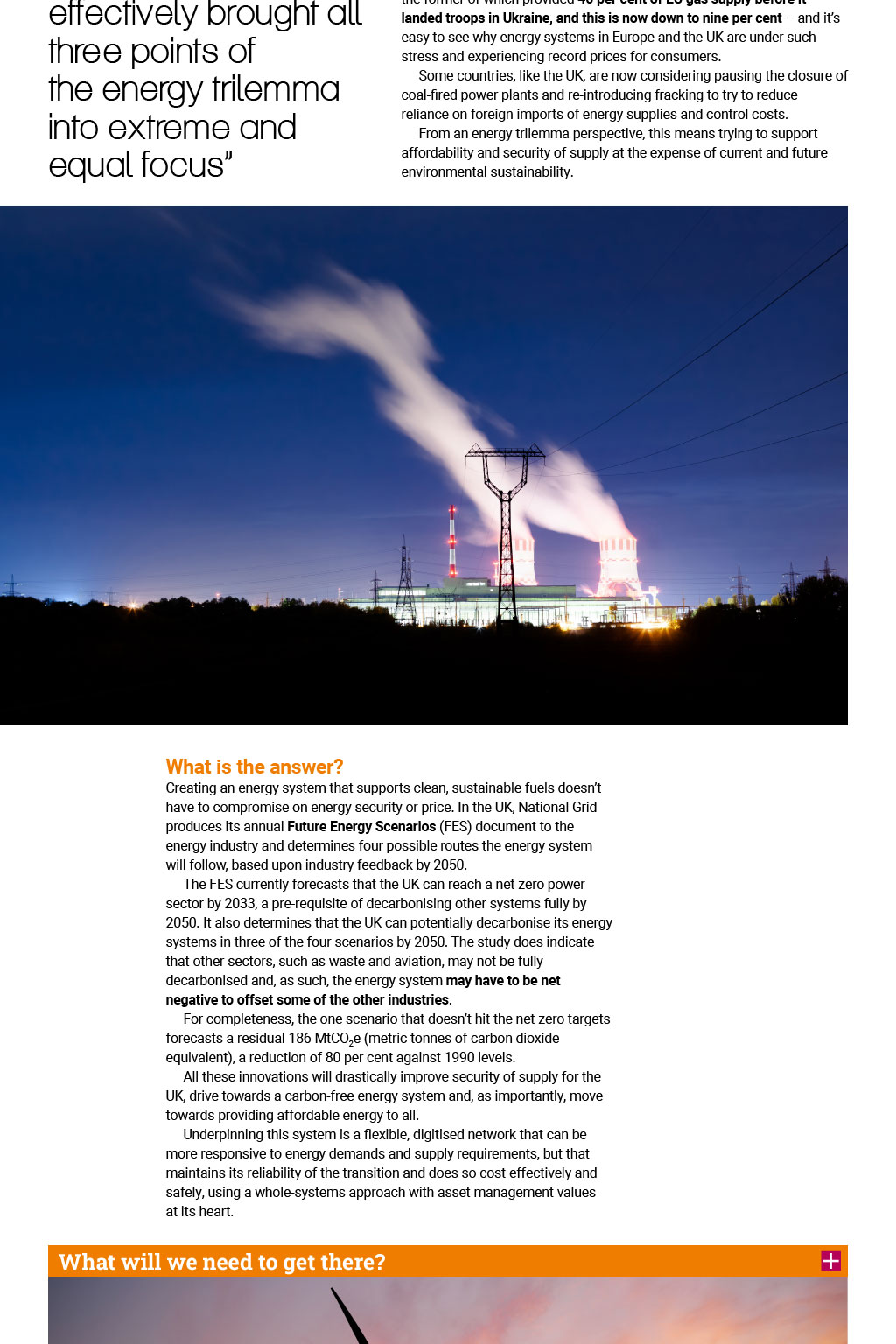
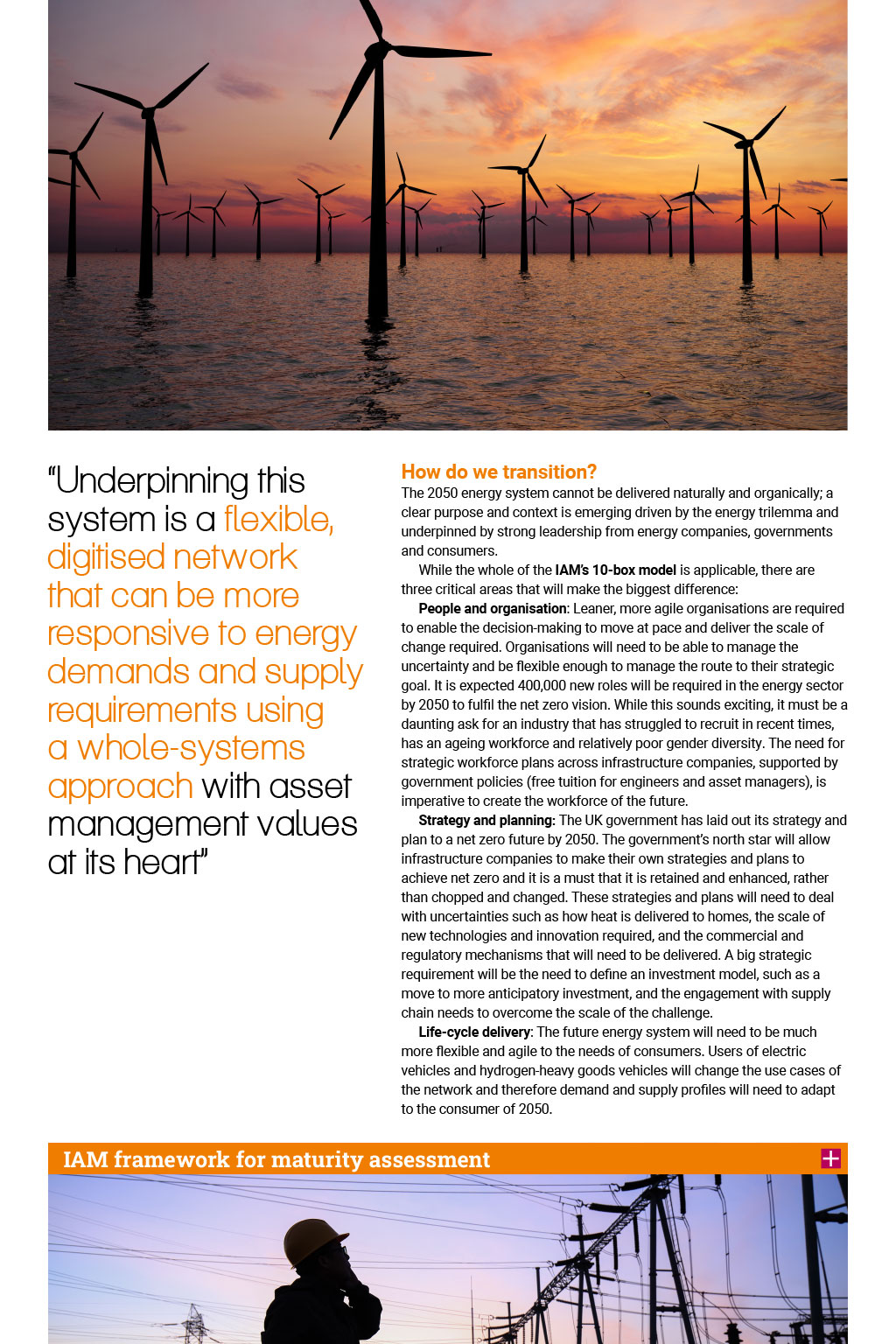
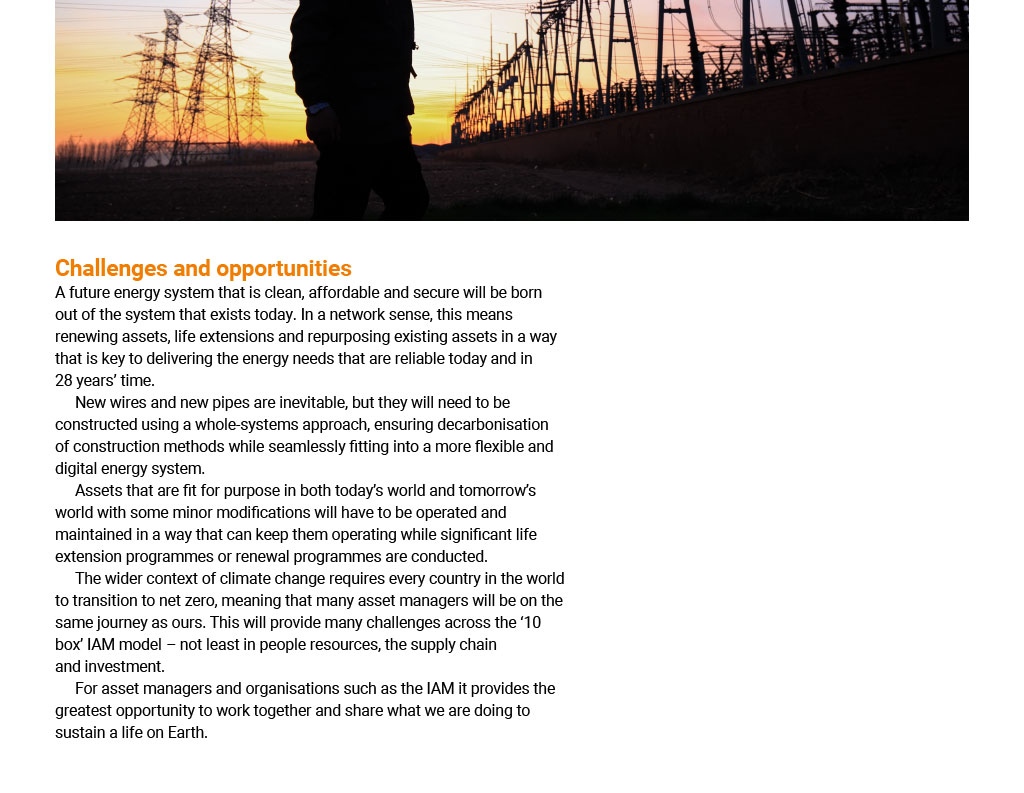






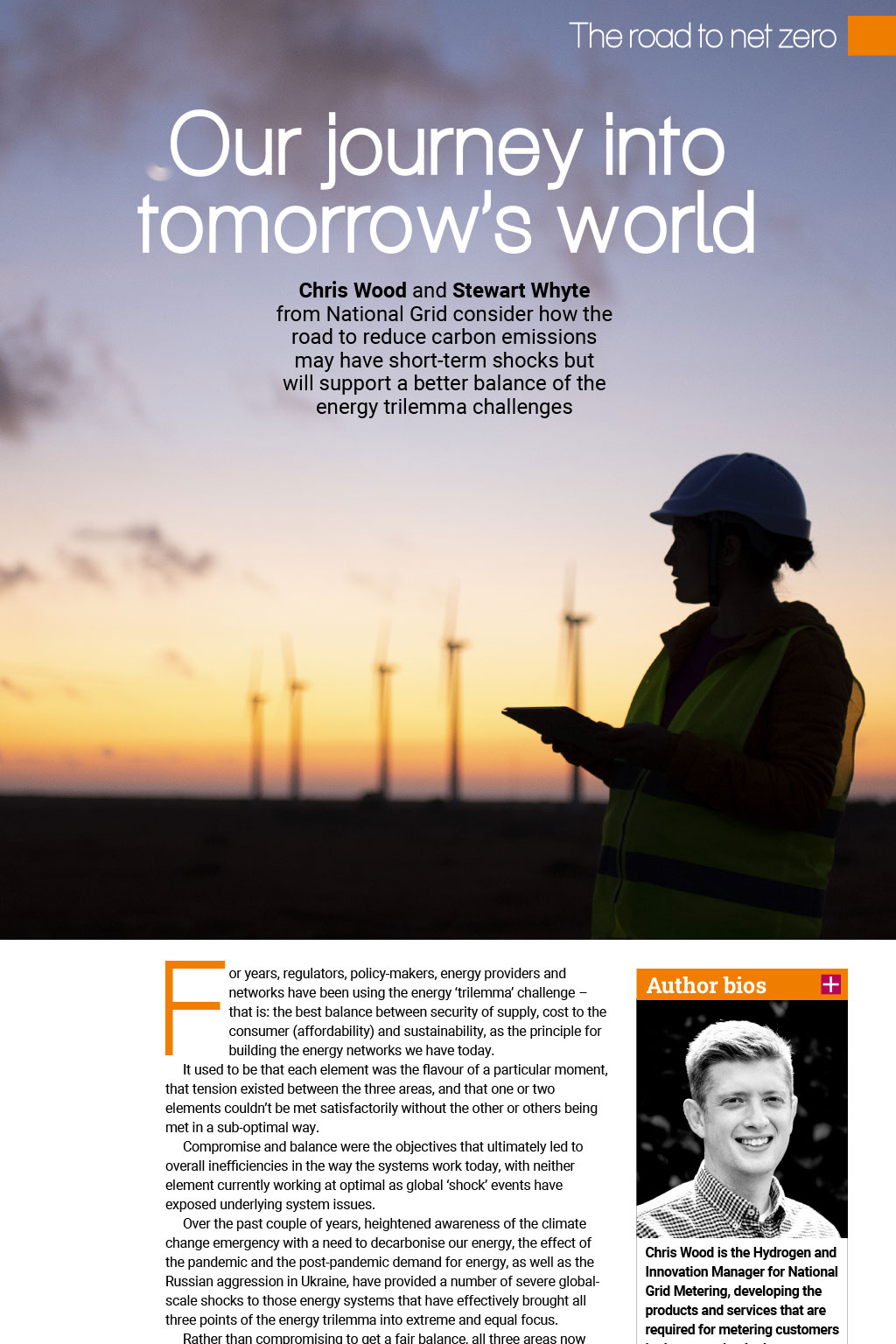
The road to net zero Our journey into tomorrowss world tomorrow Chris Wood and Stewart Whyte from National Grid consider how the road to reduce carbon emissions may have short-term shocks but will support a better balance of the energy trilemma challenges For years, regulators, policy-makers, energy providers and networks have been using the energy trilemma challenge that is: the best balance between security of supply, cost to the consumer (affordability) and sustainability, as the principle for building the energy networks we have today. It used to be that each element was the flavour of a particular moment, that tension existed between the three areas, and that one or two elements couldnt be met satisfactorily without the other or others being met in a sub-optimal way. Compromise and balance were the objectives that ultimately led to overall inefficiencies in the way the systems work today, with neither element currently working at optimal as global shock events have exposed underlying system issues. Over the past couple of years, heightened awareness of the climate change emergency with a need to decarbonise our energy, the effect of the pandemic and the post-pandemic demand for energy, as well as the Russian aggression in Ukraine, have provided a number of severe globalscale shocks to those energy systems that have effectively brought all three points of the energy trilemma into extreme and equal focus. Rather than compromising to get a fair balance, all three areas now need to be addressed simultaneously to support a clean energy transition, provide an affordable and fair price to everybody and to ensure energy systems arent held to ransom by any country engaging in unilateral and illegal action. While the situation at present is challenging, the future in the medium and long term particularly in countries like the UK looks bright. Record numbers of renewable energy supplies such as wind, marine and solar are in development; investment is back into nuclear energy for construction of traditional nuclear power plants as well as innovation on small modular reactors (SMR); and the potential for a hydrogen economy will enable energy systems that offer secure, home grown energy that is in abundance, cheap and clean. The physical transition to this future energy system requires significant capital investment in the UK, 100bn by 2030 in the building of new assets, renewing existing infrastructure and repurposing networks in order to add new connections, operating in a new and agile way, and transporting a new fuel (hydrogen). These are asset management challenges that are unprecedented and daunting. The energy trilemma Author bios Chris Wood is the Hydrogen and Innovation Manager for National Grid Metering, developing the products and services that are required for metering customers in the upcoming hydrogen economy. He is a chartered member of the IMechE and a Member of the IAM where he is a registered Asset Management Professional (AMP) and supports several committees. Stewart Whyte is the Head of Network Control and Transformation for National Grid, leading resilience and digitalisation of the control suite of systems and processes for the England and Wales highvoltage network. He is a chartered member of the IET, a Member of the IAM, Chair of the IAM UK Chapter, and a registered Asset Management Professional (AMP). AFFORDABILITY COST TO CONSUMER SECURITY OF SUPPLY How did we get here? Heightened awareness of the climate change emergency, the effect of the pandemic and Russian aggression in Ukraine have provided a number of severe global-scale shocks to energy systems that have effectively brought all three points of the energy trilemma into extreme and equal focus Since the industrial revolution in the 1700s, industrialised countries have always had carbon-intensive energy systems heavily reliant on coal, oil and, more recently, natural gas. Since 1990, countries like the UK have recognised the huge impact this has had on climate change and have began to close heavy carbon energy producers, such as coal and oil, down to rely on renewables but also, currently, still have a heavy dependence on natural gas. The UKs CO2 emissions peaked in the year 1973 and have declined by around 38 per cent since 1990, faster than any other major developed country. On 30 January 2020, the World Health Organization announced that the COVID-19 outbreak was a cause for international concern. What followed was more than 625 million infections leading to more than 6.5 million deaths. While local conditions varied, the majority of countries implemented stringent restrictions on societies which, on average, led to a reduction in global energy consumption of about 25 per cent. As societies started to re-open and adjust to a post-pandemic world, increased demand for fossil fuels such as oil and gas in the form of LNG (liquefied natural gas) across the Far East led to increases in wholesale prices for energy, with many energy markets having strong price correlations between gas and electricity (particularly in the UK where fossil fuels provide 45 per cent in 2019 of electricity generation). This led to a large increase in the average energy bill in the UK and other Western countries, and exposed several weaknesses in the existing energy system, notably a reliance on a global interconnected fossil-fueldriven system and local electricity prices with strong correlation to international gas prices. Throw in the Russian aggression with Ukraine the former of which provided 40 per cent of EU gas supply before it landed troops in Ukraine, and this is now down to nine per cent and its easy to see why energy systems in Europe and the UK are under such stress and experiencing record prices for consumers. Some countries, like the UK, are now considering pausing the closure of coal-fired power plants and re-introducing fracking to try to reduce reliance on foreign imports of energy supplies and control costs. From an energy trilemma perspective, this means trying to support affordability and security of supply at the expense of current and future environmental sustainability. What is the answer? Creating an energy system that supports clean, sustainable fuels doesnt have to compromise on energy security or price. In the UK, National Grid produces its annual Future Energy Scenarios (FES) document to the energy industry and determines four possible routes the energy system will follow, based upon industry feedback by 2050. The FES currently forecasts that the UK can reach a net zero power sector by 2033, a pre-requisite of decarbonising other systems fully by 2050. It also determines that the UK can potentially decarbonise its energy systems in three of the four scenarios by 2050. The study does indicate that other sectors, such as waste and aviation, may not be fully decarbonised and, as such, the energy system may have to be net negative to offset some of the other industries. For completeness, the one scenario that doesnt hit the net zero targets forecasts a residual 186 MtCO2e (metric tonnes of carbon dioxide equivalent), a reduction of 80 per cent against 1990 levels. All these innovations will drastically improve security of supply for the UK, drive towards a carbon-free energy system and, as importantly, move towards providing affordable energy to all. Underpinning this system is a flexible, digitised network that can be more responsive to energy demands and supply requirements, but that maintains its reliability of the transition and does so cost effectively and safely, using a whole-systems approach with asset management values at its heart. What will we need to get there? Focusing on the most optimistic yet credible scenarios, this could mean: an additional 50GW of offshore wind 40GW of network connected electrolysers 56TWh of hydrogen storage a network to transport hydrogen for heat and power generation 50GW of energy storage a significant increase in marine energy generation renewed focus on nuclear generation and innovation in small modular reactors investment in bioenergy in conjunction with a hydrogen economy, a market and assets that supports carbon capture and storage and bioenergy. Underpinning this system is a flexible, digitised network that can be more responsive to energy demands and supply requirements using a whole-systems approach with asset management values at its heart How do we transition? The 2050 energy system cannot be delivered naturally and organically; a clear purpose and context is emerging driven by the energy trilemma and underpinned by strong leadership from energy companies, governments and consumers. While the whole of the IAMs 10-box model is applicable, there are three critical areas that will make the biggest difference: People and organisation: Leaner, more agile organisations are required to enable the decision-making to move at pace and deliver the scale of change required. Organisations will need to be able to manage the uncertainty and be flexible enough to manage the route to their strategic goal. It is expected 400,000 new roles will be required in the energy sector by 2050 to fulfil the net zero vision. While this sounds exciting, it must be a daunting ask for an industry that has struggled to recruit in recent times, has an ageing workforce and relatively poor gender diversity. The need for strategic workforce plans across infrastructure companies, supported by government policies (free tuition for engineers and asset managers), is imperative to create the workforce of the future. Strategy and planning: The UK government has laid out its strategy and plan to a net zero future by 2050. The governments north star will allow infrastructure companies to make their own strategies and plans to achieve net zero and it is a must that it is retained and enhanced, rather than chopped and changed. These strategies and plans will need to deal with uncertainties such as how heat is delivered to homes, the scale of new technologies and innovation required, and the commercial and regulatory mechanisms that will need to be delivered. A big strategic requirement will be the need to define an investment model, such as a move to more anticipatory investment, and the engagement with supply chain needs to overcome the scale of the challenge. Life-cycle delivery: The future energy system will need to be much more flexible and agile to the needs of consumers. Users of electric vehicles and hydrogen-heavy goods vehicles will change the use cases of the network and therefore demand and supply profiles will need to adapt to the consumer of 2050. IAM framework for maturity assessment Purpose and context Review and continual improvement Value and outcomes Life-cycle delivery /d isp ose Information management Challenges and opportunities Op er A future energy system that is clean, affordable and secure will be born out of the system that exists today. In a network sense, this means renewing assets, life extensions and repurposing existing assets in a way that is key to delivering the energy needs that are reliable today and in 28 years time. New wires and new pipes are inevitable, but they will need to be constructed using a whole-systems approach, ensuring decarbonisation of construction methods while seamlessly fitting into a more flexible and digital energy system. Assets that are fit for purpose in both todays world and tomorrows world with some minor modifications will have to be operated and maintained in a way that can keep them operating while significant life extension programmes or renewal programmes are conducted. The wider context of climate change requires every country in the world to transition to net zero, meaning that many asset managers will be on the same journey as ours. This will provide many challenges across the 10 box IAM model not least in people resources, the supply chain and investment. For asset managers and organisations such as the IAM it provides the greatest opportunity to work together and share what we are doing to sustain a life on Earth. nt ain Asset management decision-making ew Ren Leadership, people and culture te a e cr e at Strategy and planning Acq uir e/ Governance i a M Risk management